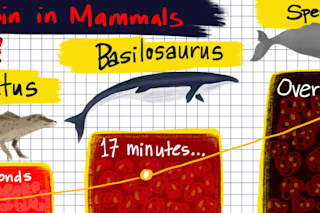The leisurely pace of a sloth or koala ambling through the forest can certainly seem desirable, but those habitats and lifestyles aren’t for everyone. For the animals tasked with surviving in some of the more extreme environments on earth, such as the oxygen-deprived ocean, or the thin air of the mountaintops, mastery of efficient oxygen uptake is essential. Several studies that recently appeared in Science shed light on the molecules involved in the abilities of certain animals to push the limits of low-oxygen living.
The fossil record shows that the body shape, limbs, and tails of mammals transitioning from land to water changed drastically to make diving mammals more efficient at hunting, hiding, and surviving in the water. But until last week, scientists didn't know much about the molecular changes that allowed for these diving behaviors. Scott Mirceta, Michael Berenbrink, and their colleagues at the University of Liverpool have not ...














